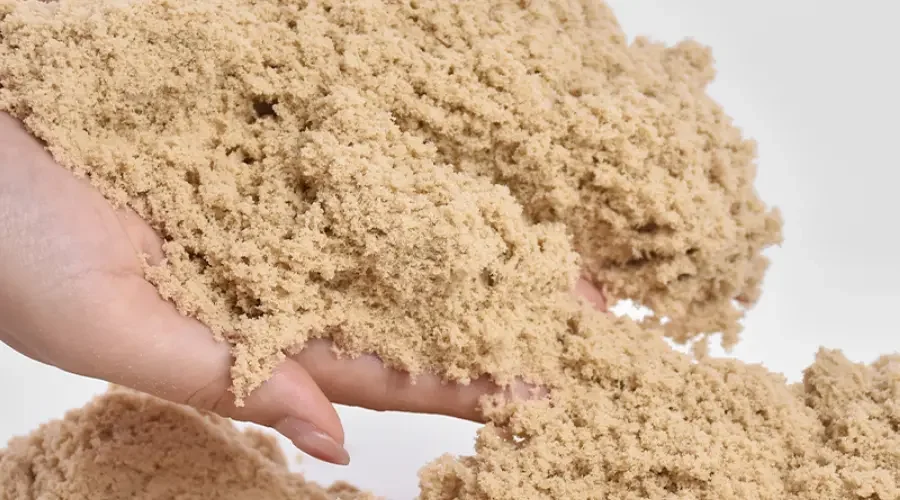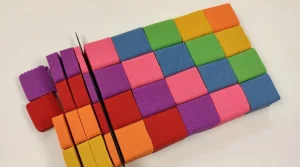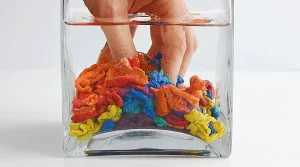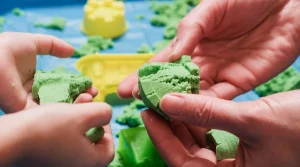
What Is Sensory Sand Made Of? The Science and Benefits
Explore what sensory sand is made of, why children love it, and how its unique materials enhance learning, creativity, and fine motor skills.
#1 Toys Manufacturer in China. WhatsApp: +86 180-0088-4063. Email: [email protected]
#1 Toys Manufacturer in China. WhatsApp: +86 180-0088-4063. Email: [email protected]

Kinetic sand is a type of sand that sticks together while still flowing through your fingers. Unlike regular sand, which crumbles apart, kinetic sand moves as if it’s alive.
It’s made of 98% sand and 2% polymer, a special ingredient that gives it that magical movement. The polymer bonds with the sand grains, making them stick to each other but not to your hands. This unique combination creates a substance that feels solid when you press it but flows like a liquid when you let it go.
The story of kinetic sand starts with its development in the early 2010s. Originally, it was designed for therapeutic use, helping children with sensory processing disorders.
One of the reasons kinetic sand has become so popular is its role in sensory play.
Sensory play is any activity that stimulates a child’s senses, and kinetic sand does this exceptionally well. Its unique texture engages touch, sight, and even sound, making it a perfect tool for sensory exploration.
Kinetic sand has also found a place in the world of ASMR (Autonomous Sensory Meridian Response).
>> Exploring Kinetic Sand: The Science Behind ASMR Effects
ASMR is a phenomenon where certain sounds or visuals trigger a tingling sensation in the scalp and spine. Many ASMR creators use kinetic sand in their videos because of its soothing sound and the way it moves. Watching someone play with kinetic sand can be incredibly calming, which is why these videos have millions of views.
Kinetic sand is made up of two main ingredients: sand grains and a special polymer.
The sand grains make up 98% of the material, providing the familiar feel of regular sand. These grains are just like the ones you’d find at the beach, but in kinetic sand, they play a different role. They’re coated with the polymer, which changes how they interact with each other.
The polymer in kinetic sand is what gives it its unique properties. This substance, which makes up 2% of kinetic sand, is a type of silicone oil. It’s what allows the sand to flow smoothly and stick together at the same time. When you press on kinetic sand, the polymer causes the grains to bond temporarily, holding their shape. But when you let go, the bonds loosen, and the sand flows like a thick liquid. This behavior is what makes kinetic sand so fascinating to play with.
The sand and polymer are both free from harmful chemicals, so parents can feel good about letting their kids play with it. Even if a small amount is accidentally ingested, it’s not harmful, though it’s still best to keep it out of our mouths.
>> Unveiling the Truth: Is Kinetic Sand Toxic for Kids
At first glance, kinetic sand might look just like regular sand, but the two couldn’t be more different. The biggest difference is in texture.
Regular sand is dry and crumbly. It flows freely and doesn’t hold a shape unless it’s wet. If you try to build something with dry sand, it just falls apart. But kinetic sand is different. Thanks to the polymer, kinetic sand sticks together and flows slowly, almost like a thick liquid.
When comparing kinetic sand to wet sand, the similarities are more noticeable. Wet sand can be molded and shaped, much like kinetic sand. However, wet sand relies on water to create its sticky texture. This water eventually evaporates, causing the sand to dry out and lose its ability to hold shapes.
Kinetic sand, on the other hand, doesn’t rely on water. It stays soft and moldable for a long time without drying out, which is one of the reasons it’s so popular.
One story that highlights these differences is that of a teacher who used kinetic sand in her classroom. She noticed that when kids played with regular sand, it often ended up all over the floor and was hard to clean up. But with kinetic sand, the mess was minimal. The kids could build structures that held their shape, and when they were done, the sand didn’t scatter everywhere.
To understand how kinetic sand works, you need to know about polymers.
Polymers are long chains of molecules that can bend, stretch, and twist in different ways. They’re found in many everyday materials, from plastics to rubber bands. In kinetic sand, the polymer is what gives the sand its unusual properties.
When kinetic sand is made, the sand grains are coated with a thin layer of polymer. This coating helps the sand grains stick together just enough to form shapes, but not so much that they clump up like wet sand. The polymer allows the sand to flow smoothly, creating that satisfying, almost liquid-like movement when you play with it. It’s the polymer that turns regular sand into kinetic sand, giving it that special touch.
The way kinetic sand sticks together and flows isn’t just about polymers. It also involves something called Van der Waals forces. These are tiny forces that happen between molecules when they’re close to each other. In kinetic sand, Van der Waals forces help the sand grains stick to one another without getting too sticky.
When you press on kinetic sand, these forces hold the grains together, letting you shape the sand. But when you stop pressing, the forces are weak enough to let the sand flow and fall apart.
Friction and cohesion also play a big part in how kinetic sand moves.
One way to see these forces in action is by comparing kinetic sand to dry sand. Dry sand has high friction and low cohesion, so it doesn’t hold a shape well. Kinetic sand, with its perfect mix of friction and cohesion, flows just right—smooth, steady, and always satisfying.
Kinetic sand is not just about building shapes or watching it flow; it’s also about how it feels. When you pick it up, it feels soft and smooth, almost like a mix between wet sand and dough. The sand is cool to the touch, and when you squeeze it, it holds its shape for a moment before slowly melting away. This sensation is both relaxing and satisfying, making it a favorite for sensory play.
Texture plays a huge role in why kinetic sand is so enjoyable. Unlike regular sand, which can feel rough or gritty, kinetic sand has a silky, almost slippery feel. This texture makes it perfect for sensory play, especially for children who might be sensitive to rough textures.
When kids run their fingers through kinetic sand, they’re not just playing—they’re exploring different sensations that can help them develop fine motor skills and hand-eye coordination. For many, the feeling of kinetic sand slipping through their fingers is calming, helping to reduce stress and anxiety.
Kinetic sand has found a unique place in the world of ASMR (Autonomous Sensory Meridian Response). ASMR videos are designed to trigger a tingling sensation in the scalp and neck, often referred to as “tingles.” These videos often feature soothing sounds and visuals, and kinetic sand is a perfect fit. The sound of kinetic sand being sliced, molded, or crumbled can be incredibly calming. It’s soft, almost like a whisper, and the way the sand moves is visually mesmerizing.
In ASMR videos, creators often use tools to cut or shape the sand, enhancing the sensory experience. The slow, deliberate movements and the soft crunching sound of the sand are what draw people in. Some viewers find that watching these videos helps them relax or fall asleep. The psychological effects of playing with kinetic sand, or even just watching someone else play with it, can be profound. It taps into a basic human need for soothing sensory experiences, offering a way to unwind and disconnect from the stresses of daily life.
Kinetic sand isn’t just a fun toy—it’s also a valuable tool in education, especially in STEM (Science, Technology, Engineering, and Math) learning. Teachers use kinetic sand to help kids understand concepts like physics, engineering, and even chemistry.
In early childhood development, kinetic sand plays an important role too. The tactile experience of squeezing, molding, and shaping the sand helps young children develop fine motor skills. It’s also a great way for them to learn about textures and materials. Plus, kinetic sand is safe and non-toxic, making it perfect for classroom use. Kids can experiment with building and creating, all while learning basic concepts that will help them as they grow.
Kinetic sand isn’t just for learning; it’s also used in therapy, especially occupational therapy. For people with sensory processing disorders, kinetic sand can be a comforting and engaging tool. Its soft texture and the way it flows between fingers make it ideal for sensory integration exercises.
Many people find that playing with kinetic sand helps them unwind after a long day. The simple act of letting the sand flow through your fingers or watching it slowly collapse can be incredibly calming. It offers a way to focus the mind and reduce anxiety, much like meditation. The calming effects of kinetic sand are so strong that some therapists even recommend it for patients dealing with high stress or anxiety.
A therapist once told the story of a client who found kinetic sand to be a breakthrough in managing her anxiety. The client would keep a small container of kinetic sand on her desk at work, and whenever she felt overwhelmed, she’d take a few minutes to play with it. This simple act helped her regain control and continue with her day.
In creative play, kinetic sand is often used for building castles, animals, and other imaginative shapes. Because it’s easy to mold and doesn’t dry out, kids can play with it for hours, creating and recreating different scenes. This kind of open-ended play encourages creativity and problem-solving. Kids learn to think about structure, balance, and how different shapes fit together, all while having fun.
>> Sensory Playtime: Innovative Ways to Enjoy Kinetic Sand
One artist shared how they used kinetic sand to create a series of sculptures that were designed to erode and change over time. The project was a way to explore the theme of impermanence, with the kinetic sand perfectly capturing the idea of something that is always in motion, never completely still.
Kinetic sand is easy to care for, but keeping it clean is key to making it last. Since kinetic sand doesn’t dry out, it’s best to store it in an airtight container when not in use. This keeps dust and dirt out, ensuring that your sand stays fresh and fun to play with. If you notice small debris like crumbs or hair in the sand, you can remove them by picking them out or sifting the sand through a mesh strainer.
Over time, kinetic sand can lose some of its magic, becoming less moldable or a bit sticky. To refresh old kinetic sand, try adding a few drops of water and mixing it well. This can help restore its texture and make it feel like new again. If the sand feels too dry, knead it thoroughly with a few more drops of water. Avoid adding too much water at once, as this could make the sand too sticky.
Even though kinetic sand is generally low-maintenance, you might encounter some common problems.
If the sand becomes too sticky, it could be because it’s been exposed to too much moisture. To fix this, try spreading the sand out on a flat surface and letting it air dry for a few hours. This should help remove the excess moisture and bring the sand back to its normal texture.
On the other hand, if the kinetic sand feels dry or crumbly, it’s likely due to a lack of moisture. Adding a few drops of water and mixing it thoroughly should solve the problem. Be patient—kneading the sand takes a bit of time, but it’s worth it to get that perfect flow back.
Clumpy kinetic sand can also be a challenge. This often happens if the sand hasn’t been stored properly or has been packed too tightly. To break up clumps, gently knead the sand with your hands, separating the clumps as you go. You can also use a rolling pin or similar tool to help smooth out the sand.
In conclusion, kinetic sand offers a unique blend of science, creativity, and sensory satisfaction. Whether used in educational settings, therapy, or just for fun, maintaining your kinetic sand is simple with the right care. By keeping it clean and troubleshooting common issues, you can enjoy endless hours of tactile exploration.
Kinetic sand offers a unique sensory experience that differs from slime and playdough. Unlike slime, which is sticky and stretchy, kinetic sand is grainy but still holds together, offering a flowy texture. Unlike playdough, which can dry out if left uncovered, kinetic sand stays moist and pliable, making it easier to clean up and less prone to sticking to surfaces. This distinct combination of properties makes kinetic sand particularly engaging for children, as it combines the best aspects of various sensory materials.
Kinetic sand is versatile and can be enjoyed by a wide range of age groups. It is generally safe for children as young as three, provided they are supervised to prevent accidental ingestion. Young children benefit from the tactile stimulation and fine motor skill development, while older children and even adults find kinetic sand relaxing and useful for stress relief. Its versatility makes it a great option for mixed-age playgroups, where different age groups can engage with the material in their own ways.
Kinetic sand is a powerful tool for teaching STEM concepts, especially in areas like physics and engineering. Children can experiment with kinetic sand to learn about gravity, friction, and the principles of construction. For example, they can build bridges or towers and observe how different designs hold up under pressure. These hands-on activities help solidify abstract STEM concepts by turning them into tangible, interactive experiences, making learning both fun and educational.
Kinetic sand is generally considered safe and non-toxic, but its environmental impact depends on the specific brand and ingredients used. Most kinetic sand products are made from natural sand combined with synthetic polymers. While these materials are safe for human use, it's important to check whether the product is recyclable or biodegradable. Some manufacturers are now offering eco-friendly versions that use organic binders and recyclable packaging to reduce environmental impact.
Yes, kinetic sand is increasingly used in therapeutic settings, particularly in occupational therapy and mental health. Its soothing, tactile nature makes it ideal for stress relief and anxiety reduction. Therapists often use kinetic sand to help patients improve fine motor skills, focus, and sensory processing. The act of manipulating the sand can be calming, helping individuals to relax and express themselves non-verbally, making it a valuable tool in both physical and emotional therapy contexts.
More Related...

Explore what sensory sand is made of, why children love it, and how its unique materials enhance learning, creativity, and fine motor skills.

Discover what makes kinetic sand so special — from its unique texture to the fascinating science behind its magical movement.

Is magic sand safe for kids? Explore safety facts, age guidelines, and expert advice to ensure fun, creative, and secure sensory play.

Kinetic sand toys offer fun and education in one—find out how they support child development, relaxation, and imaginative play.

Our team will answer your inquiries within 48 hours.
Copyright © 2025 GuangDong AKIA Technology Co,. Ltd. All Rights Reserved